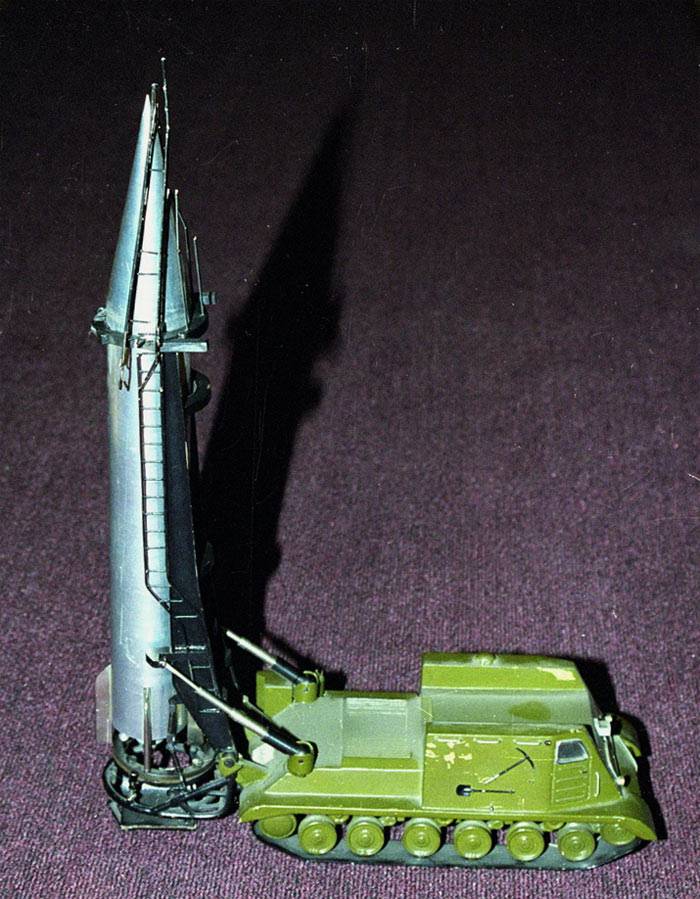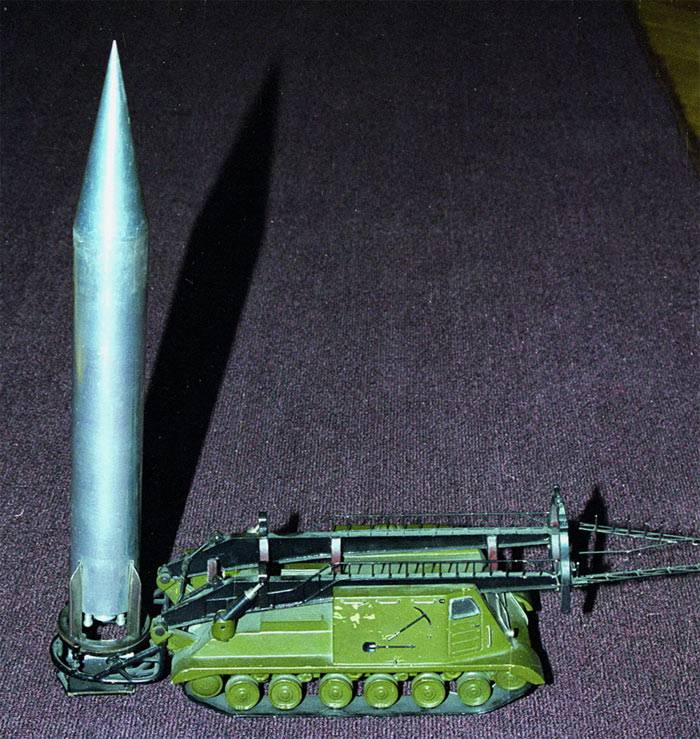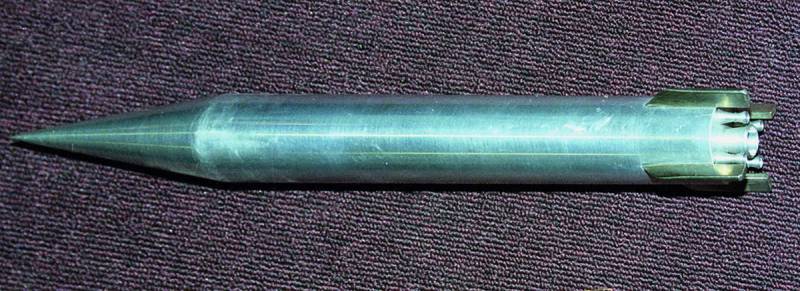The project of operational-tactical missile system with a missile R-18
Since the mid-fifties, employees of SKB-385 (Miass) under the direction of V.P. Makeeva worked on the project of the D-2 submarine missile system with the P-13 missile. Certain successes of this project, outlined by 1958 year, allowed to proceed to the further development of this development, which should have led to the emergence of a new version of the missile system. 28 August 1958 of the year issued a decree of the Council of Ministers of the USSR on the development of a new operational-tactical complex, which should be based on existing developments on the latest missiles for submarines. Moreover, one of the project variants implied the use of the maximum possible number of assemblies and assemblies of the existing product.

The layout shows the rocket lift to the starting position.
In accordance with the decision of the Council of Ministers, SKB-385 was to develop a missile system based on a self-propelled chassis with a missile capable of delivering a special warhead to a range of up to 600 km. To simplify and speed up the development, the project was to be based on the groundwork for the D-2 / P-13 complex. In the first quarter of 1959, the developer organization was supposed to submit a draft version of the project, and by the beginning of 60, the project should have been brought to flight testing. It was supposed to complete all the work on the new project and adopt the complex by the middle of 1961. Prospective ballistic missile for ground forces received the designation P-18. The exact name of the complex is unknown.
The head developer of the new project was to be SKB-385. It was also planned to involve in the works the Leningrad Kirov Plant, which was assigned to design a self-propelled launcher. In addition, in order to meet the deadlines, plant No. 385 (Chelyabinsk) should be subordinated to SKB-66.
According to available data, within the framework of the P-18 project, it was proposed to develop two versions of the rocket with a different design. The first was planned to create on the basis of existing experience, with minimal borrowing of finished components and assemblies. The second version, in turn, was to become a modified version of the “sea” P-13 rocket and have maximum unification with it. Regardless of the type of missile, the complex should have included a self-propelled crawler launcher.
It is known that the self-propelled launcher or launcher for the P-18 rocket is called the “812 Object”. This machine was to be based on the design of ACS ISU-152K. The Leningrad Kirov Plant already had some experience in rebuilding self-propelled guns into launchers, which should have been used in a new project. For this reason, the finished "812 Object" should have had a certain similarity with machines from other missile systems of the time.
The basis of the “Object 812” was a tracked chassis, based on existing units. It had a diesel engine B-2-IC with power 520 HP. and received a mechanical transmission. On each side of the hull, six small diameter road wheels with an individual torsion suspension were provided. Such a power plant and chassis had to provide movement on highways and rough terrain with the overcoming of various obstacles necessary for the delivery of a ballistic missile to the launch position.
The chassis was mounted housing characteristic design with a large front cabin and aft engine compartment. In front of the cabin, which had a low central part of the roof, were placed space for the crew. Access to the inside of the cabin was carried out through the front side doors, and the driver's seat was located in front of the hull and was equipped with large front windows. In addition to the crew, there was a set of equipment necessary for topoprivity, preparing the rocket for launch and performing other procedures.
On the stern of the hull were the supports for the rocking devices of the launcher. Next to them were placed the supporting devices of the hydraulic drives for lifting the rocket. For the transportation of the P-18 rocket, the “812 Object” received a ramp. This device was supposed to be a set of beams and transverse curved elements with grippers on which a rocket was placed and fixed in the transport position. For additional protection of the product, large grilles were located on the side and head parts of the ramp. In the first place, they were necessary to protect the head of the rocket from possible impacts when moving over rough terrain.
It was proposed to launch the rocket using a compact launch pad. On the main frame of this device was mounted a support ring for the installation of the rocket, gas shield and other necessary equipment. The frame of the launch pad was mounted on hinges, placed on the supports of the swinging ramp. Due to this, the table could be raised to the transport position or lowered to the working position.
Together with the “812 Object”, the “811 Object” transport-charging machine was to be operated. It was planned to build on the same chassis as the self-propelled launcher. The differences between the two cars should have been in the set of special equipment. Thus, the “811 Object” should have been equipped with means for transporting and reloading the missile to the launcher. Possibility of lifting to vertical position, starting table, etc. absent.
In the future, it was planned to develop a new version of the self-propelled launcher on a wheeled chassis. By that time, it was already known that tracked vehicles have a number of negative features that impede their use as a carrier of missiles with special combat units. Wheeled chassis differed more soft ride and did not have serious limitations. Thus, in perspective, the wheeled vehicle with the required characteristics could become the carrier of the P-18 rocket. The exact appearance of such a machine, however, was not determined due to the early shutdown of work.
Exact information about the first version of the P-18 rocket project, which was planned to be developed from scratch, is not available. It is possible that within a few months of work on the complex, the specialists of the developer organization simply did not have time to shape the look of such a product and determine its technical features. As for the version of the P-18 rocket, based on the P-13 design, in this case there is enough information to make a complete picture.
Being a slightly modified version of the P-13 submarine missile, the P-18 product should have retained all its main features. The P-18 was supposed to be a single-stage liquid ballistic missile with onboard control systems. During the development of a new project, SKB-385 specialists had to change some of the design features of the rocket due to a different method of application and other characteristic features of the land complex. However, such changes should not have led to a significant change in the characteristics or appearance of the rocket.
The P-18 rocket was supposed to have a cylindrical body of large elongation with a large conical head fairing. At the tail there were small stabilizers X-shaped design. Other large and visible parts on the outer surface of the case were absent. It was proposed to use a standard layout of internal volumes with the placement of the warhead inside the head fairing, the engine in the tail and tanks in the remaining volumes. The location of the control equipment could be borrowed from the P-13 project: this rocket had a small inter-tank compartment with guidance systems located near the center of gravity.
The unification of the new rocket with the existing one should have resulted in the use of the C2.713 type liquid rocket engine. This product had one large marching chamber and four smaller helmsmen. The central marching chamber was responsible for creating the thrust, and the side steering could be used for maneuvering. To do this, they had the opportunity to swing around the axes perpendicular to the longitudinal axis of the rocket. The engine was supposed to use TG-02 fuel and an AK-27I oxidizer. Engine thrust reached 25,7 t.
According to some reports, the P-18 rocket was decided to be equipped with a new guidance system, which is the development of existing units. An inertial guidance system capable of tracking rocket movements and generating commands for engine steering chambers was planned to be created using devices derived from the P-17 rocket project. The basis of the required guidance systems were gyroscopes, as well as new computational tools.
It was planned to equip the ballistic missile with a special combat unit, the development of which should have been assigned to KB-11. The parameters of such a combat unit are unknown, but the dimensions and characteristics of the rocket made it possible to carry a warhead with a capacity of up to 1 Mt.
The base model P-13 rocket had a length of 11,835 m and the maximum diameter of 1,3 m with a span of stabilizers 1,91 m. The starting weight of the product reached 13,75 t. and weight characteristics.
In accordance with the terms of reference, the missile system with the P-18 rocket should have been able to attack targets at ranges from 250 to 600 km. The maximum deviation from the calculated point of entry should not exceed 4 km in any direction, which imposes the corresponding requirements for guidance systems.
No more than 1 hours were assigned to the preparation of the missile system for firing after arriving at the position. During this time, the calculation of the self-propelled launcher was supposed to lower the launch pad on the ground, then lift the rocket into a vertical position, fix it on the desk and lower the ramp. At the same time, the coordinates of the machine were determined, and a flight program was calculated, designed to be entered into the rocket control systems. After completion of all necessary procedures, a run could be performed.
The launch of the rocket was proposed to be carried out from a vertical position, without using a starting rail. During the active leg of the flight, the automatics should have kept the rocket on the desired trajectory. After the fuel was developed, the rocket was supposed to go on an uncontrolled flight along a predetermined trajectory. After completing the shooting, the crew of the “812 Object” could transfer the complex to the transport position and go to another site to perform reloading.
The development of the P-18 rocket project and other means of a promising operational-tactical missile complex continued until December of the 1958 year. By this time, the specialists of SKB-385 and other organizations involved in the project had time to work through some questions and prepare a set of documentation in a draft version. In addition, apparently, it was at this time that a certain number of mock-ups of a self-propelled rocket launcher were made.
At the end of 1958, work on the R-18 project was discontinued. The exact reasons for this are unknown, but there are some suggestions. The most plausible version is that associated with a change in the goals and objectives of SKB-385. Until the end of the fifties, this organization was engaged in the development of missile systems of various classes intended for use by various types of armed forces. Later, it was decided to entrust SKB-385 specialists with only projects developed in the interests of fleet. Thus, in the future, Miass designers were supposed to develop only ballistic missiles of submarines. The development of land complexes was entrusted to other organizations.

Fighting vehicle ready for launch
For these or perhaps other reasons, by the beginning of 1959, all work on the P-18 rocket had been stopped, stopping at the early stages. Sketch design of a new missile system was not completed. As a result, the technical design was not developed, and the experimental products were not built or tested. The ground forces did not receive an operational-tactical complex with the possibility of firing at a distance of up to 600 km.
After the project was closed, SKB-385 has some technical documentation left. In addition, by this time, models of promising products were collected. One model of the machine "Object 812" with a rocket P-18 is now stored in the museum of the Kirov plant (St. Petersburg), at one time responsible for the development of a self-propelled launcher.
Due to the cessation of work on the SKB-385 land-based missile systems, it was not possible in the future to implement the small experience gained in creating the P-18 project. In the future, this organization was engaged only in missile systems for submarines, where the developments on self-propelled launchers, etc. could not find applications. Nevertheless, there is an opinion that the ideas and decisions of the P-18 project were nevertheless implemented in practice, even with significant changes.
Among foreign historians of military equipment there is a version about the use of groundwork for the P-18 rocket by North Korean engineers in their land missile systems projects. Documentation on the Soviet project could get to the DPRK, where it was used to create the Nodon family of missiles. At the same time direct evidence of this version has not yet been cited, there is only indirect evidence that can be interpreted in its favor.
In the late 1950s, Soviet engineers worked on several projects of advanced missile systems for the ground forces. Developed systems with different variants of the chassis, different missiles, different characteristics and types of warheads. Not all such developments, for one reason or another, managed to reach mass production and operation in the military. In addition, in some cases, the project has not even been completed. One of these unsuccessful developments was the project of the complex with the P-18 rocket. Its closure at the end of 1958 did not allow testing in practice the potential and prospects for the unification of modern ballistic missiles of submarines and ground complexes.
On the materials of the sites:
http://bastion-karpenko.narod.ru/
http://rbase.new-factoria.ru/
http://militaryrussia.ru/blog/topic-301.html
- Ryabov Kirill
- Bastion-karpenko.ru, Militaryrussia.ru

Information